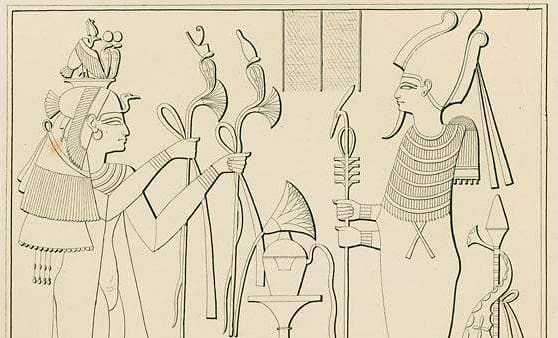
(Not to be confused with Queen Tiye – The Elder Lady)
Ramesses III’s reign consisted of a group of problems. There were threats of foreign invasions and bad harvests. This led to food shortages and civil unrest.[1] However, he also had a large harem and produced ten sons. This was to be his greatest headache and would lead to his death. At the end of his life, his minor wife, Queen Tiye, was planning to murder him and make her son pharaoh. If she succeeded, she would be the most powerful woman in the realm. This became known in history as the “Harem Conspiracy”.[2] While there have been many royal women who hatched plots within the harem, this one is the most scandalous and the most famous. This may be perhaps because it is the most documented harem conspiracy of the Ancient Egyptian era.[3]
Queen Tiye was a secondary wife of Ramesses III. We do not know much about her, but it is believed that she was of commoner status. At one point, she gave birth to a son named Pentaweret.[4] Because Queen Tiye was a secondary wife, she had a small chance of ever having her son be the next pharaoh. She was not the “King’s Great Royal Wife”. The title was given to Ramesses III’s principal wife, Iset Ta-Hemjert.[5] Ramesses III had already named Ramesses Heqamaatre-Meriamun (the future Ramesses IV and his eldest son by his chief queen) to be his successor.[6] Queen Tiye would live out the rest of her days in the harem in anonymity.
However, Queen Tiye did try to make her move to get out of the harem. She had ambitions to be the mother of the pharaoh. She wanted to put her son on the throne.[7] To make this happen, she was willing to commit murder, even if it meant her husband. Her goal was to stage a coup. She would have Ramesses III killed, and her son would usurp the throne.[8]
However, planning a coup was a dangerous and risky step. How would Queen Tiye manage to form a coup and be successful? Even though Queen Tiye was only a minor wife of Ramesses III, she must have wielded considerable influence within the harem. According to the Judicial Turin Papyrus, which is an Ancient Egyptian document that recorded the trials of the “Harem Conspiracy” against Ramesses III, shows that at least thirty-eight people were involved.[9] Many of these officials were very powerful. One of them was Pebekkhamen, who was the chief of Ramesses III’s chamber.[10] Others were also harem officials who were closely associated with the pharaoh.[11]
The murder was to take place during the Opet Festival in Thebes.[12] According to the Lee Papyrus, in order to prepare for the assassination, they took a book filled with magical spells from the pharaoh’s own library and made wax figurines with the intent to kill him by witchcraft.[13] The attack took place during the Festival while Ramesses III was at his Medinet Habu Temple.[14] Was the attack successful? The debate is still up in the air. According to Zahi Hawass, Ramesses III died immediately during the attack because his throat was cut.[15] However, other scholars believe that he was wounded, arrested the conspirators, and later died of his wounds during the trials.[16]
Whether or not the assassination of Ramesses III was successful, it did not matter. Queen Tiye’s plans of making her son Pharoah backfired. The Judicial Papyrus recounts four separate trials and the punishment. against the officials and her son, Pentaweret.[17] All of the thirty-eight officials were condemned to death.[18] Pentaweret, whom Queen Tiye had rested her future on, was found guilty and was forced to commit suicide.[19] There is no record of Queen Tiye’s trial or her punishments, but historians believe that she too was forced to commit suicide.[20] Ramesses Heqamaatre-Meriamun became Ramesses IV.
Queen Tiye’s plot seems like the makings of an evil queen in a fairy tale. She was a woman of ambition and influence who was willing to murder her husband to become the mother of the pharaoh just to escape harem life. In the end, though, she was found out and was given her just desserts and cost the lives of dozens of others.
Sources:
“The Harem in Ancient Egypt.” Ancient Egyptian Institutions: The Harem,
www.reshafim.org.il/ad/egypt/institutions/harem.htm.
Dunn, Jimmy. “Ramesses III, Egypt’s Last, Great Pharaoh.” Tour Egypt,
www.touregypt.net/featurestories/ramessesiii.htm.
Hawass, Zahi, et al. “Revisiting the Harem Conspiracy and Death of Ramesses III:
Anthropological, Forensic, Radiological, and Genetic Study.” BMJ : British Medical
Journal, vol. 345, no. dec14 14, 2012, pp. e8268-e8268.
“Records of the Harem Conspiracy against Ramses III: The Judicial Turin Papyrus, Rollin
Papyrus and Lee Papyrus.” Records of the Harem Conspiracy against Ramses III,
www.reshafim.org.il/ad/egypt/texts/judicial_turin_papyrus.htm.
Teeter, Emily. Religion and Ritual in Ancient Egypt. Cambridge Univ. Press, 2012.
Tyldesley, Joyce. “Foremost of Women: The Female Pharaohs of Ancient Egypt.” Tausret:
Forgotten Queen and Pharaoh of Egypt, edited by Richard H. Wilkinson, 1st ed.,
Oxford University Press, 2012, pp. 5–25.
[1] Tyldesley, p. 20
[2] Hawass, Zahi, et al. para. 4
[3] The Harem In Ancient Egypt, para. 13
[4] Teeter, p. 179
[5] Tyldesley, p. 20
[6] Teeter, p. 179
[7] Teeter, p. 179
[8] Tyldesley, p. 20
[9] Tyldesley, p. 20
[10] Records of the Harem Conspiracy against Ramses III, para. 5
[11] Dunn, para. 11
[12] Dunn, para. 12
[13] Teeter, p. 179
[14] Tyldesley, p. 20
[15] Hawass, Zahi, et al. para. 17
[16] Hawass, Zahi, et al. para. 3
[17] Hawass, Zahi, et al. para. 1
[18] Tyldesley, p. 20
[19] Tyldesley, p. 20
[20] Tyldesley, p. 20

Be the first to comment